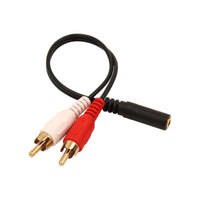Contents
Audio connectors play a crucial role in the entertainment and audio industries. If you’re a lighting technician or an audio engineer, you may be familiar with DMX and XLR connectors. But if you’re new to lighting or engineering, you may confuse these two connectors. DMX and XLR feature very similar appearances, but they have distinct characteristics and are used for different purposes. This article helps you distinguish between DMX and LXR connectors, helping you choose the appropriate one.
What is an XLR Cable?
XLR, short for External Line Return, is widely used in the audio industry. XLR connectors were originally built to keep a reliable connection in military aircraft and later have been gradually used for various audio devices.
The XLR cable is usually terminated with a 3-pin XLR connector. Each pin has its own function, for example, pin 1 is used for ground wire, and pin 2 and 3 are used for negative and positive signal transfer separately. Sometimes, the XLR cable features 5-pin connectors on both two ends, the extra 2 pins are often used for future expansion. 5-pin XLR cables are generally used for binaural recording devices and stereo mic setups.
XLR cables can deliver balanced signals over a long distance, which can avoid unwanted interference and noise. XLR cables are often shielded in daily use and widely used in various audio equipment, such as microphones, mixers, speakers, and amplifiers.

What is a DMX Cable?
DMX, which stands for Digital Multiplex, is a digital communication protocol developed in 1986. DMX cables use the same connector as XLR cables, but they are not designed for transmitting audio signals. They are all about data transmission between the light and the source. The DMX cable has 512 channels that are known as “DMX Universe”. Each channel has data values of 0~255, which is designed for controlling lighting attributes like color, intensity, and strobe, with higher values yielding a stronger effect. For large-scale events requiring numerous lights, 512 channels may not be enough and the use of multiple DMX Universes is necessary to manage the larger digital data for better lighting effects.
DMX cables should only use 5-pin connectors, but in fact, 3-pin connectors are often used in the lighting industry. 5-pin to 3-pin and 3-pin to 5-pin adapters can be a solution when your connector can’t match your device. DMX cables are typically used for lighting and other entertainment systems.

DMX vs. XLR: What are the Differences?
Though you may find DMX cable and XLR cable similar in appearance, they actually differ significantly in several aspects. The following will highlight the distinctions between DMX and XLR.
-
Connector: DMX connectors usually come to be 3-pin or 5-pin connectors.3-pin DMX cables are used for regular lighting control applications, while 5-pin DMX cables are more common in large and professional lighting setups. In contrast, XLR uses 3-pin connectors in most audio applications.
5-pin connectors’ pin placement comes in three types: 180-degree, 240-degree, and 270-degree layout. The most common type is the 180-degree 5-pin DMX connector.
- Signals: DMX cables carry digital signals, while XLR cables carry analog audio signals.
- Impedance: DMX cables require an impedance of 110 ohms to handle data transmission. Though the actual impedance of the cable can vary from different manufacturer, XLR cables typically have an impedance ranging from 45 ohms to 75 ohms to deal with the analog audio signals.
- Primary Use:DMX cables are specialized for lighting control applications, such as LED fixtures and dimmers in live performances. They are extensively used in stage lighting, concert lighting, theater productions, and other entertainment lighting applications. XLR cables are audio cables primarily applied to audio equipment for high-quality audio performance. They are widely used in recording studios and broadcasting. XLR is compatible with many audio formats like 3.5mm, RCA, and SpeakOn, making it suitable for various audio devices.
It’s difficult to distinguish DMX and XLR cables in terms of their connectors, and you should check the specs on the cable jacket to identify whether your cable is DMX or XLR. But what can you do to distinguish DMX and XLR cables if they are not labeled? In general, XLR cables are more flexible, and DMX cables are designed to be more rugged than XLR cables. DMX cables usually have a tight shielding part. If you mistakenly use DMX cables for your audio equipment, you’ll find a decline in audio quality; while using XLR cables lighting setups may lead to flickering illumination.
Can I Replace DMX With XLR or XLR With DMX?
You may be confused about whether DMX and XLR connectors are interchangeable as they have a similar appearance. We don’t recommend you do that. DMX and XLR have different requirements for impedance. The former generally requires 110 Ohms, while the latter only requires 45~75 Ohms impedance.
Replacing DMX with XLR or XLR with DMX may not damage your devices, but it can cause other problems. Because DMX and XLR cables carry different voltages, replacing the DMX cables with XLR cables can result in signal degradation or loss. You may see light flickering or going out when you do this. In addition, connecting a DMX cable to an audio device may cause noise, which will affect the audio quality. DMX cables can also be less durable than XLR cables when connecting to audio devices.
In short, DMX is designed for lighting and XLR for audio respectively. To get optimal performance and maintain their long-term use, you are not supposed to replace them with each other.
Final Thoughts
DMX cables are involved in lighting design and control applications and XLR cables are primarily used in audio engineering and sound management in various entertainment applications. Understanding their differences helps ensure proper usage and optimal performance in their respective domains.
FAQs
Are DMX cables the same as XLR cables?
No, they have the same connectors but different impedances. DMX cables are used for lighting while XLR cables are used for audio.
How long can you run a DMX cable?
Theoretically, a DMX cable has a running length of up to 3281 feet (1000 m), but it is recommended the length ranges from 1000 to 1500 feet (300~460 m) in practice.
Do XLR cables make a difference in sound quality?
Yes. With the help of XLR cables, the sound quality can be improved with low signal loss and little outer interference like noise.
For more information on this topic, you can keep up on our blogs. While VCELINK offers general and basic information for our customers and other visitors to the website, it’s not professional advice.





Be the first one to comment.
Leave a comment